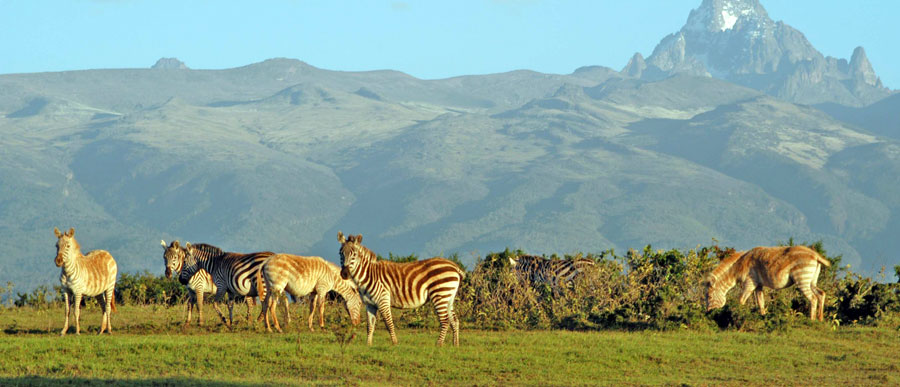
Stunning landscapes, rich wildlife and divine tranquillity are all entrenched into the fabric of Kenya. For many years now it has been the number one safari destination in Africa, if not the world but that is not all it has going for it, there are the people who are delightfully diverse and welcoming while its capital of Nairobi offers a slice of Africa you did not know exists.
Masai Mara Game Reserve
The Masai Mara is Kenya's finest and most outstanding wildlife sanctuary where gentle rolling grassland ensures animals are never out of sight. The climate is gentle, rarely too hot with well spread rainfall year round. The sensational sight of the great wildebeest migration between July and October is unparalleled. The wildlife is far from being confined within the Reserve boundaries too and an even larger area extends beyond the game Reserve. Centuries of close association with the wildlife has resulted in an almost symbiotic relationship where wildlife and Maasai people live in peace with one another. The first sight of this Game Park is breathtaking. There is nowhere else on earth to compare with this wildlife marvel; this is without doubt the quintessential Kenyan safari destination. The combination of a gentle climate, scenic splendour and untold numbers of wildlife makes the Masai Mara National Reserve Kenya's most popular inland destination.
The big blue skies and open savannahs have been adulated and adored for many years now and it is a lot of people’s favourite place in Africa, mostly because it of a certain spirit which lingers over the place and draws people in far and wide who leave aesthetically replenished and their soul suitably nourished.
Amboseli National Park
After Masai Mara, Amboseli National Park is the most frequented park in Kenya. This has something to do with the wondrous image of elephants grazing with a backdrop of Mount Kilimanjaro, creating the quintessential Kenyan wildlife shot. The chance to get close to free ranging elephants is not the only reason to be drawn into the park, there is also a great chance to meet Maasai people and visit a Maasai village and gain a unique perspective into the Kenyan way of life.
What makes this park so cherished is the fact that Amboseli offers some of the very best opportunities in the whole of Africa to see some fauna because its vegetation is sparse due to the long dry months. There are five main wildlife habitats plus a generally dry lake-bed, Lake Amboseli from which the park takes its name. Other habitats range from open plains to stands of fever trees, thick thorn-bush and swamps and marshes. Making this a veritable haven for wildlife to flourish, on a game drive you are likely to see elephants, lions, leopards, cheetahs and the Maasai giraffe. Bird life is also abundant, particularly amongst the swamps and lakes where you can see a large variety of water birds, these include pelicans, kingfishers, crakes and lilytrotters.
Lake Nakuru National Park
Lake Nakuru National Park is dominated by a gentle undulating terrain with open bush and woodlands, typical of the dry rift valley vegetation. 27 percent of the park is composed of the Lake Nakuru waters. The Park itself was declared a Rhino Sanctuary in 1983 and the Rhino stocking program which ensued received white rhinos from South Africa.
Currently the sanctuary has approximately 45 black and 31 white rhinoceros. The Park lies in the volcanic – strewn Great Rift Valley. Without doubt the main attraction of the park is the lake, which is world famous as the location of the greatest bird spectacle on earth. Pink flamingos whose numbers are legion, often reaching more than one million gather here and is an incredible spectacle to behold. Large sized python snakes that inhabit the dense woodlands, and can often be seen crossing the roads or dangling from trees. While the lake water is highly saline but supports a habitat rich in biodiversity including a variety of aquatic flora and fauna. The lake is also inhabited by water mammals, mainly hippopotamus and claw less otters while the terrestrial part of the park supports a large number of other African plain mammals.
Tsavo National Parks
The combined area of Tsavo East and West National Parks makes Tsavo one of the world’s largest game sanctuaries, covering an area of more than 20,000 kilometres. Tsavo West has more than 2,000 km of well-maintained un-paved roads that lead from one natural wonder to another. Chief among these ranks the marvel of Mzima Springs, replenished with twenty million litres of crystal-clear water a day from the underground streams of the nearby Chyulu Hills. The springs form a haven for many different animal species. Tiptoeing across the bottom, apparently weightless, you will find the surprisingly light-footed but ponderous Hippo.
Crocodiles bask in the heat of the day taking an occasional swirl in the water while gazelles, giraffes and zebras wander around the banks through thick acacia, among hundreds of chattering birds. Among the less common animals to be found in Tsavo, are the Fringe-eared Oryx, the Gerenuk and Hunter's hartebeest. The carnivores in addition to Lion, Leopard and Cheetah, include Caracal and Hyena making this an unbelievable place to bask in the natures glory.
Great travel articles as well as deals, all sent directly to your inbox. Sign up today!
